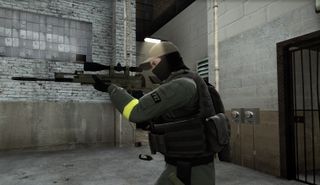How to scout in CS:GO and win without fighting

Evan writes about CS:GO and other FPSes each Monday in Triggernometry.
Counter-Strike became a more interesting game to me the moment I embraced that it's as much about information gathering as it is about gathering sick AWP noscopes.
In a five-on-five format—the way you should be playing Counter-Strike, regardless of your skill level—CS shrinks to a size that fits in your brain. Every player action—footsteps, reloads—produces information, and every information piece paints a clearer picture of what the enemy team is up to that you're meant to adapt your tactics and positioning to.
You play within a possibility space shaped by bottlenecks and fixed spawn positions, and this distinguishes CS from other FPSes, which begs the question: are you playing CS like it's a different game?
It’s obvious that Battlefield 4, for example, is spatially larger than CS:GO. But think about the way that BF4’s scale, along with the design of its respawn systems, make information decay quickly. Players can spawn on one another, on any owned capture point, or parachute from the sky—the three medics you saw on capture point D a moment ago can multiply into a dozen by the time the tank you've called in arrives. It's a game of fluctuating hotspots mostly played on open, flankable terrain. It's a game about putting out fires and starting your own.
CS, by contrast, is a checkerboard slowly revealed as you move through it. There are only so many positions an enemy can occupy, and unless you leave a hole in your collective vision, they can't magically appear behind you through teleportation. Where enemies are (and, secondarily, what resources they have (HP, armor, weapons)) is reliable information with a measurable lifespan. Without having some of that information, you're simply hoping for the best, relying on your aim to get you out of every situation.
Embrace scouting as a necessary aspect of Counter-Strike, and you may improve your win rate on the way to appreciating the tiny maneuvers that drive CS' strategic depth.
The biggest gaming news, reviews and hardware deals
Keep up to date with the most important stories and the best deals, as picked by the PC Gamer team.
Jump-Scouting
It was during the ESL One Cologne that I finally realized I could win rounds of Counter-Strike with my eyes. There's a position on de_mirage beside the van on bombsite B, and I watched teams jump like kangaroos here, elevating their eyes for a moment each time to peek down apartments. Even if the Terrorists are rushing B flat-out, this move buys the defenders a few more seconds to get their asses to the bomsite, which can absolutely make a difference. (If you're daring, you can also land jumping Scout or AWP shots.)
This was a huge epiphany for me; up until then, I'd been hurling smoke into the Mirage apartments at the start of every round on the assumption that someone was there. Smoke has the ability to stop pushes and burn precious time off the clock, but deploying it there was also denying me the opportunity to gather visual information. I was putting myself in a position to be surprised every round and hoping that my aim could get me out of it.
Few maps offer the jump maneuver I mentioned on de_mirage as a quick, usually-safe scouting option. More often, the technique you want is a shoulder peek: making the smallest possible movement around a corner with no intention of engaging. The whole idea of the shoulder peek is to not stick your neck out long enough to even observe enemies, but 'process' what you've seen behind cover. You're snapping a quick photo, jerking back, then essentially looking at it in your own brain while you're safe. Do this with a knife out to be as fast as possible.
We’ll dig into shoulder peeking more another week. The takeaway here is that in CS' five-on-five format there's an unusually high value to knowing where enemies are: it determines your aim, positioning, and grenade tosses—three essential elements of CS. Part of playing well, then, means learning how to gain information with as little risk to your resources (HP and the weapons you're carrying) as possible. Recognizing the map locations and round situations where information is available at a low cost (i.e. risk to your team’s lives, position, or weapons) is a valuable step to playing a more deliberate game.

Evan's a hardcore FPS enthusiast who joined PC Gamer in 2008. After an era spent publishing reviews, news, and cover features, he now oversees editorial operations for PC Gamer worldwide, including setting policy, training, and editing stories written by the wider team. His most-played FPSes are CS:GO, Team Fortress 2, Team Fortress Classic, Rainbow Six Siege, and Arma 2. His first multiplayer FPS was Quake 2, played on serial LAN in his uncle's basement, the ideal conditions for instilling a lifelong fondness for fragging. Evan also leads production of the PC Gaming Show, the annual E3 showcase event dedicated to PC gaming.
Most Popular


